Theme Parks & Themed Entertainment
When WDW Had a Racetrack – The Creation of the Walt Disney World Speedway
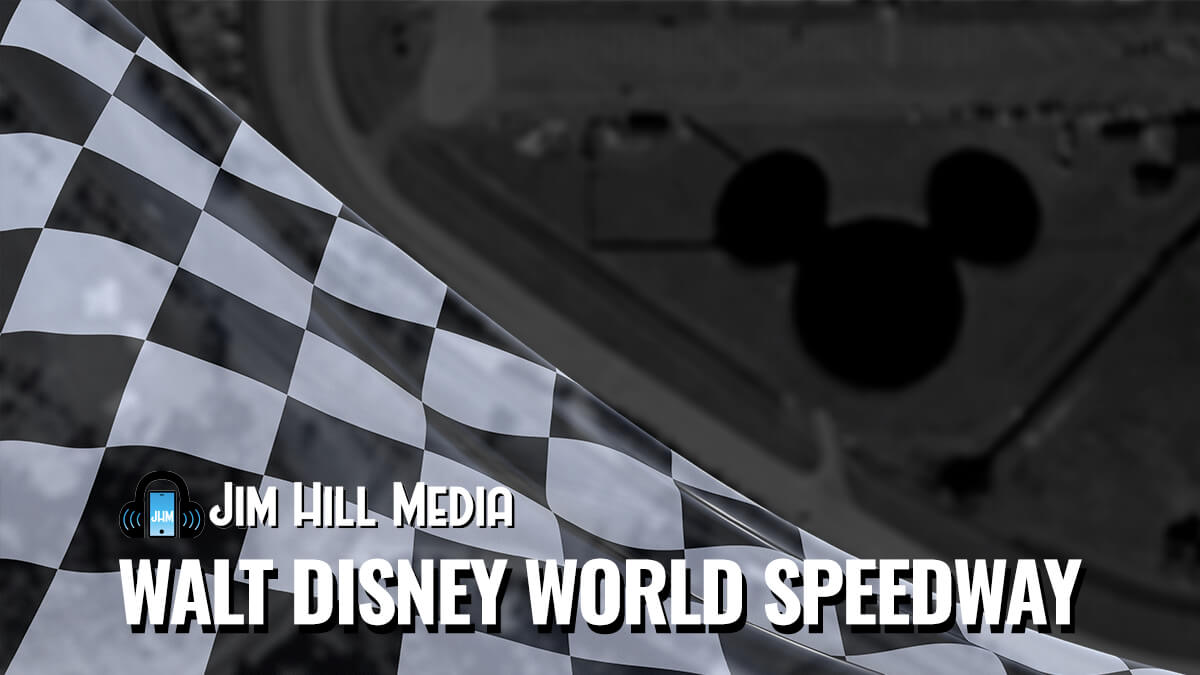
A few months back, when Len Testa & I recorded a Bandcamp exclusive podcast – the one where we attempted to walk from the Ticket & Transportation Center at Walt Disney World all the way over to the Magic Kingdom, only to then be stymied by all of the construction at the Grand Floridian.
Anyway … As I was driving over to the Poly to meet Mr. Testa, I made use of that new flyover ramp that now directly connects World Drive with Floridian Way. Which gave me a brief glimpse down into the southeastern corner of the Magic Kingdom Parking Lot. Which – from 1995 – 2015 – was home to the Walt Disney World Speedway. Or – as Indy Car fans used to like to call that one mile long, three turn tri-oval track – the Mickyard.
That name is – of course – a Disney-ified play on the Brickyard, the 2.5 mile-long track which is probably better known as the Indianapolis Motor Speedway. Which is where the Indy 500 is held every May .
And the Indy 500 actually plays a crucial role in the creation of Walt Disney World Speedway in Orlando. For the seed for this $6 million project was planted just eight months after Michael Eisner first became the CEO of The Walt Disney Company.
“The Wonderful World of Disney” Indy 500
Mind you, this is back when Michael was doing everything he could to get the Disney name & its characters out in front of as many people as possible. Which is why – for the running of the 70th edition of the Indy 500 back in 1985 – Eisner cut a deal with the folks who staged that race to have that year’s Indy 500 Fest themed to “The Wonderful World of Disney.”
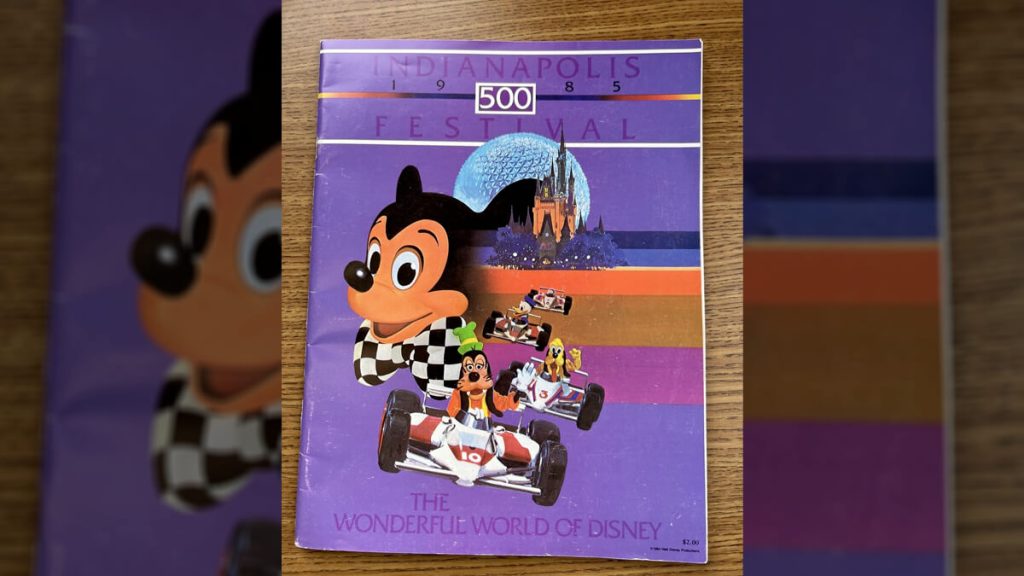
As Michael tells this story:
Jeffrey Katzenberg & I flew out to Indianapolis in 1985 to attend that year’s Indy 500. So we’re sitting in the stands with 500,000 people. And there’s this parade that’s held inside of the Speedway before the official start of the race where cars with celebrities and politicians roll by.
So first the governor of Indiana goes by, and there is polite applause. Then Mickey Mouse goes by his car, and there is more applause from the crowd at the Speedway. Which makes me feel good about the Disney characters. But then Jim Varney goes by in a car dressed as Ernest and 500,000 people go berzerk.
That’s when I turn to Jeffrey Katzenberg and say “’We should probably do something about that.’
Right after that race, Disney roped Varney into doing four “Ernest” movies (which were then released under the Walt Disney Pictures banner from 1987 – 1991). Jim also voiced Slinky Dog in the first two “Toy Story” films before we tragically lost Jim in February of 2000. And that was all because Michael Eisner went to the Indianapolis 500 just 8 months after he became Disney’s CEO.
Disney Get’s Into Sports
But what Michael also remembered from that trip in Indiana was those 500,000 people who were seated in the stands at the Indianapolis Motor Speedway. Now you have to remember that – when the Bass Brothers (Those were those billionaires from Texas who had helped Eisner land his new job at Disney back in late September of 1984) – Michael had been told by Sid Bass that Priority No. One was developing Walt Disney World. Taking those 40 square miles of swampland that the Company owned in Central Florida and finding all sorts of new ways that Disney could then profit off of that property.
And Michael Eisner? He liked sports. Anyone who was paying attention during the 20+ years that Michael ran the Mouse House knows this. After all, on Eisner’s watch, we got:
- The Mighty Ducks of Anaheim, a Disney-owned NHL team in 1993
- The Walt Disney World Marathon got underway in 1994
- Later that same year (1994), the All-Star Resort opened at Walt Disney World
- It bought ESPN in 1995 (That was part of Disney’s $19 billion acquisition of ABC / Cap Cities)
- Disney bought the Los Angeles Angels from Gene Autry in 1996 and then renamed this baseball team the Anaheim Angels
- It opened Disney’s Wide World of Sports Complex in Florida in 1997 (That 220-acre facility was rebranded as the Wide World of Sports Complex in 2010)
That’s obviously a lot of sports-related stuff. But today we’re here to talk about the Walt Disney World Speedway.
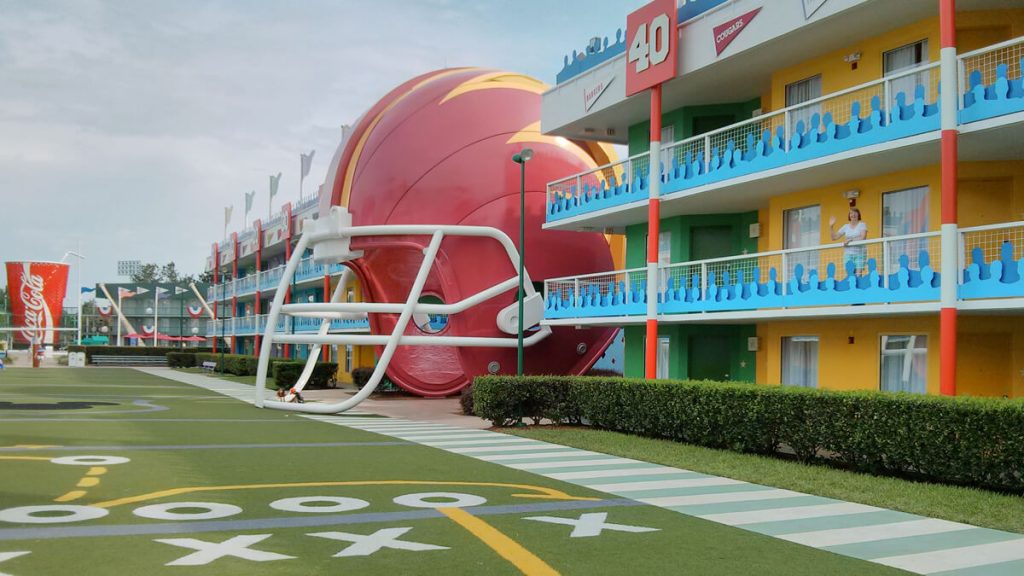
Why Build the Walt Disney World Speedway?
Eisner first broached the idea of building a race track somewhere on property in Florida with the Imagineers in the mid-to-late 1980s. Mind you, by this time, work was already well underway on the Disney-MGM Studio Tour project. So the thinking back then was “Let’s finish Disney World’s third gate first. Then we can circle back around to that thing that the Boss wants us to do that we’ve never, ever done before.”
The question then became … Well, where would be the very best place to build such an enterprise? And after visiting a number of speedways around the country (Not to mention reviewing the television coverage of the past few Indy 500s), what the Imagineers realized is that … Well, for the two weeks leading up to the actual race (This was when the Indy 500 trials were being held), the Goodyear Blimp would fly back and forth over the Indianapolis Motor Speedway.
And since a big part of those marching orders the Bass Brothers gave Michael Eisner back in the Fall of 1984 was “You guys really need to do a better job of promoting Walt Disney World” … Well, here’s the decision tree that eventually led to the Imagineers proposing to Eisner that they place the Walt Disney World Speedway in the lower southeastern corner of the Magic Kingdom’s parking lot.
- Michael wants us to build a raceway in Florida. Something that could then help lure Guests to the Walt Disney World Resort during those times of year when attendance is really soft at the Parks.
- We have the Magic Kingdom’s parking lot. 125 acres of previously prepped, already graded land which has room for 12,000 cars but is rarely if ever full.
- If we were to build this raceway in the lower southwestern corner of the Magic Kingdom parking (the part of that parking lot that only gets used during the busiest times of year, like Fourth of July, Christmas or New Years), if a blimp were to cover a race that were staged at the Walt Disney World Speedway, the WDW Resorts around Seven Seas Lagoon & Bay Lake (not to mention the Magic Kingdom itself) would virtually be guaranteed to be on camera multiple times during the live broadcast of this race. Which would then translate into millions of dollars in free advertising for the WDW Resort.
Let’s also not overlook the fact that – because of the site prep that already been done on this corner of Walt Disney World property / how all of this acreage in the lower southwestern corner of the Magic Kingdom parking lot had been graded back in late 1969 / early 1970 when the WDW Resort was first being built, the Walt Disney World Speedway team could really hit the ground running here. Not to mention save tons when it came to the traditional construction start-up costs.
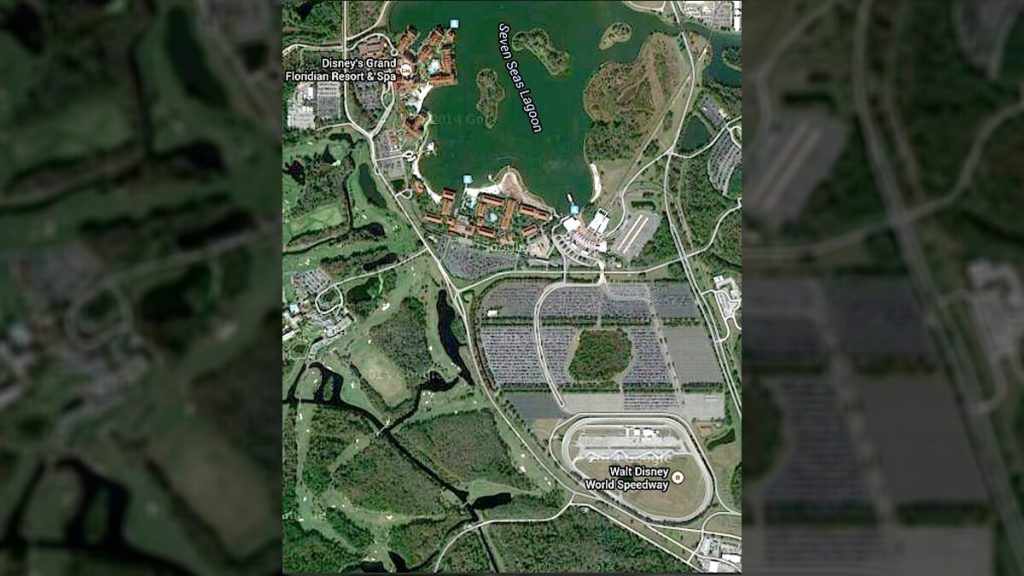
Building the Walt Disney World Speedway
Initial survey work on the project was done in secret in September of 1994 by Buena Vista Construction. The project was formally announced on January 23, 1995. With the very first race to be held at the venue – the inaugural Indy 200 – being announced at a press conference which was held on April 13th of that same year.

Just to be clear here: The very first race to be held at the Walt Disney World Speedway wouldn’t get underway ‘til January of the following year. January 27, 1996, to be exact. (That’s basically a full year after this project was first announced. And we’ll get to the significance of that January 27th date in a moment).
Anyway … The official groundbreaking on the Walt Disney World Speedway wasn’t held ‘til June 27, 1995. That’s when Mari Hulman George (She was the Chairman of the Board of the Indianapolis Motor Speedway) flew down to Walt Disney World to take part in this ceremony. During which – to make sure that the racing press understood that there was going to be a very strong connection between the Brickyard and the Mickyard – Ms. George presented WDW officials with one of the original paving bricks that was used to create the Brickyard back in Indiana back in 1909.
Weird bit of trivia: It took 3.2 million of these 9 & a half pound bricks to pave the full circuit of that 2.5 mile long, rectangular oval course back in the day. I wonder if Ms. George opted to make that ceremonial brick her carry-on when she flew from Indy down to Disney?
After this groundbreaking ceremony, construction of the Walt Disney World Speedway began in earnest. As pavers laid down 5,200 tons of asphalt to create this race track’s surface, construction crews poured 1,800 yards of concrete to form the Speedway’s outside walls. Which were then strung with 10 miles worth of safety restraint cabling. And a similar amount of effort went into the creation of this Speedway’s pit row area. With an additional 2,300 feet of concrete being poured there.
And did I mention that the Summer of 1995 was one of the soggiest in Central Florida history, with 75 inches of rain falling between the months of June & July of that year alone? Which (as you might guess) really hampered Buena Vista Construction’s effort to keep the Walt Disney World Speedway project on schedule.
But by October 18th of that year, the final bit of paving on this one mile long, three-turn tri-oval (which had been designed by Kevin Forbes, the chief engineer of the Indianapolis Motor Speedway. Again with the idea of stressing that there was going to be this strong connection between the Mickyard & the Brickyard) was done. This $6 million project was then formally dedicated on November 28, 1995 in an elaborate ceremony which included Indy racing legends forming a five-car “Flying V” formation as they zoomed around this track while fireworks exploded overhead.
Why all this publicity? Because the inaugural Indy 200 was supposed to be the first-ever event staged by the Indy Racing League. More to the point, the date for the televised debut of the Walt Disney World Speedway had been carefully selected by the Mouse’s marketing team & Indy Racing League managers. You see, January 27th wasn’t just any Saturday. It was the day before Super Bowl 1996 was staged.
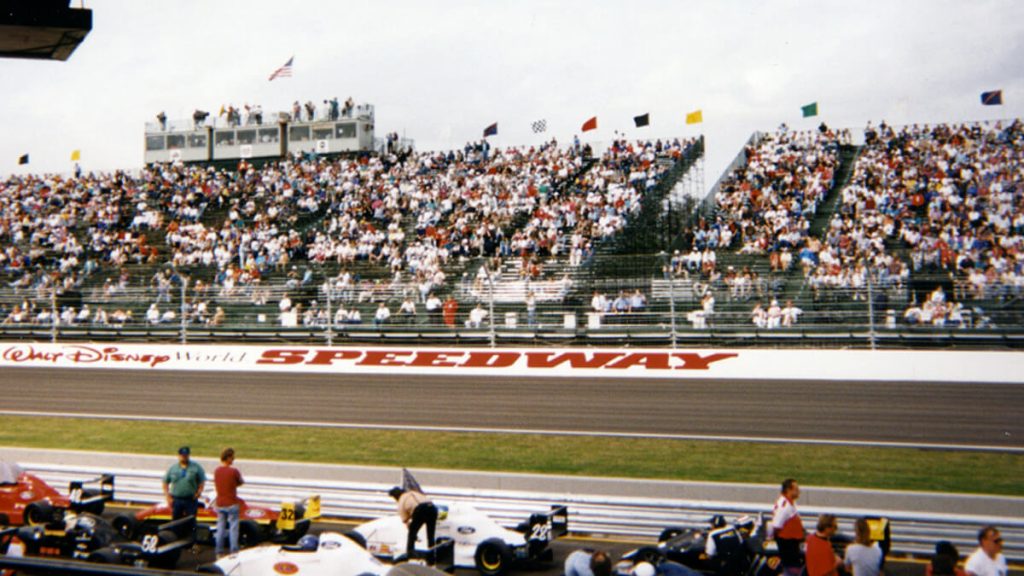
A New Pre-Super Bowl Tradition
A little background here: Michael Eisner started his career in television in 1966 (he was hired to be Barry Diller’s assistant. Who – at that time, anyway – was ABC’s national programming director). Which meant that Eisner had a front row seat when the very first Super Bowl was broadcast in January of 1967. Over the next two+ decades, Michael watched as the Super Bowl steadily grew in popularity ‘til it then became this broadcasting behemoth.
So Eisner knew – from personal experience – that a televised sporting event that was properly positioned & promoted could eventually become this enormous thing. And as I mentioned earlier into today’s story … The Walt Disney Company had acquired ABC / Cap Cities back in 1995 for $19 billion. Which include ABC Sports & ESPN.
So if Disney (and the folks at the Indy Racing League, of course) handled the televised debut of the inaugural Indy 200 at Walt Disney World just right … Well, the Indy 200 wouldn’t just become the first professional auto race of the year. It could also become a brand-new television tradition. The race that sports fans watched the day before the Super Bowl.
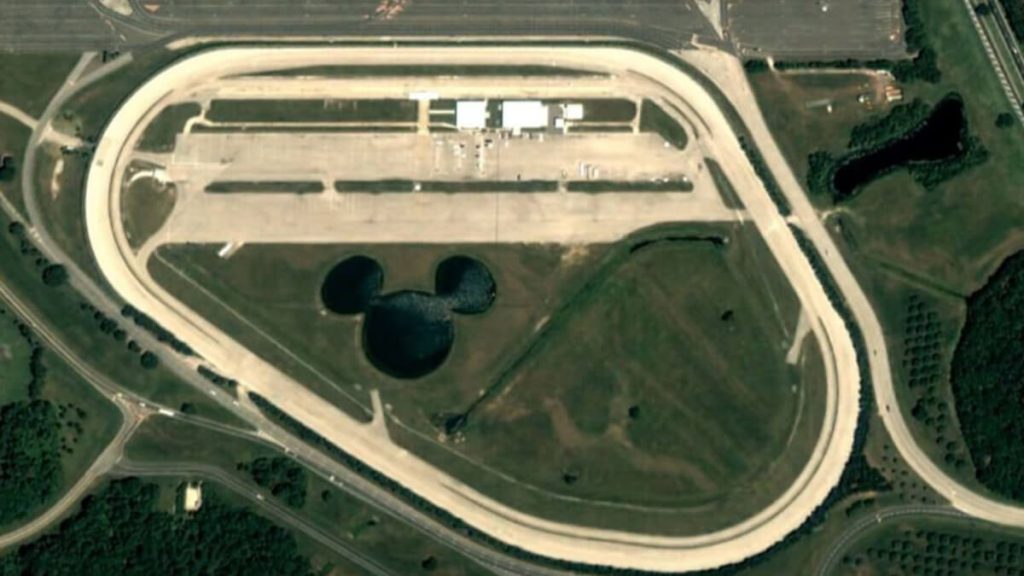
Indy 2000 Failure
Sadly, all the ambitious plans that the Mouse & the Indy Racing League originally had for this corner of the Magic Kingdom parking lot never came to fruition. And by January of 2000, the Indy 200 was pretty much defunct. At least as far as the Walt Disney World Speedway was concerned.
So why did this highly anticipated, seemingly can’t-miss project eventually wind up as the home of the severely under-utilized Richard Petty Driving Experience? Only to finally be shuttered in 2015 and then be turned back into a parking lot?
We’ll get to that part of this story on the second & final installment of this series.
This article is based on research for The Disney Dish Podcast “Episode 433”, published on June 26, 2023. The Disney Dish Podcast is part of the Jim Hill Media Podcast Network.
Theme Parks & Themed Entertainment
Disney and Macy’s 90-Year Thanksgiving Day Parade Partnership: From Mickey’s First Balloon to Minnie’s Big Debut

Now, folks, if you’re like me, Thanksgiving just wouldn’t be the same without a coffee, a cozy seat, and Macy’s Thanksgiving Day Parade on the TV. And if you’re really like me, you’re watching for one thing: Disney balloons floating down 34th Street. Ever wondered how Mickey, Donald, and soon Minnie Mouse found their way into this beloved New York tradition? Well, grab your popcorn because we’re diving into nearly 90 years of Disney’s partnership with Macy’s.
The Very First Parade and the Early Days of Balloons
The Macy’s Thanksgiving Day Parade goes way back to 1924, but if you can believe it, balloons weren’t part of the festivities until 1927. That first lineup included Felix the Cat, a dragon, and a toy soldier, all towering above the crowds. Back then, Macy’s had a pretty wild idea to end the parade: they would let the balloons drift off into the sky, free as birds. But this wasn’t just Macy’s feeling generous. Each balloon had a message attached, offering a $100 reward (about $1,800 in today’s dollars) for anyone who returned it to the flagship store on 34th Street.
And here’s where it gets interesting. This tradition carried on for a few years, right up until 1932, when Felix the Cat almost took down a plane flying over New York City! Imagine that—you’re flying into LaGuardia, and suddenly, there’s a 60-foot balloon drifting toward your wing. Needless to say, that was the end of Macy’s “fly away” stunt, and from then on, the balloons have stayed firmly grounded after the parade ends.

1934: Mickey Mouse Floats In, and Disney Joins the Parade
It was 1934 when Mickey Mouse finally made his grand debut in the Macy’s parade. Rumor has it Walt Disney himself collaborated with Macy’s on the design, and by today’s standards, that first Mickey balloon was a bit of a rough cut. This early Mickey had a hotdog-shaped body, and those oversized ears gave him a slightly lopsided look. But no one seemed to mind. Mickey was there, larger than life, floating down the streets of New York, and the crowd loved him.
Mickey wasn’t alone that year. He was joined by Pluto, Horace Horsecollar, and even the Big Bad Wolf and Practical Pig from The Three Little Pigs, making it a full Disney lineup for the first time. Back then, Disney wasn’t yet the entertainment powerhouse we know today, so for Walt, getting these characters in the parade meant making a deal. Macy’s required its star logo to be featured on each Disney balloon—a small concession that set the stage for Disney’s long-standing presence in the parade.
Duck Joins and Towers Over Mickey
A year later, in 1935, Macy’s introduced Donald Duck to the lineup, and here’s where things got interesting. Mickey may have been the first Disney character to float through the parade, but Donald made a huge splash—literally. His balloon was an enormous 60 feet tall and 65 feet long, towering over Mickey’s 40-foot frame. Donald quickly became a fan favorite, appearing in the lineup for several years before being retired.
Fast-forward a few decades, and Donald was back for a special appearance in 1984 to celebrate his 50th birthday. Macy’s dug the balloon out of storage, re-inflated it, and sent Donald down 34th Street once again, bringing a bit of nostalgia to the holiday crowd.
A Somber Parade in 2001
Now, one of my most memorable trips to the parade was in 2001, just weeks after the 9/11 attacks. Nancy and I, along with our friends, headed down to New York, and the mood was something I’ll never forget. We watched the start of the parade from Central Park West, but before that, we went to the Museum of Natural History the night before to see the balloons being inflated. They were covered in massive cargo nets, with sandbags holding them down. It’s surreal to see these enormous balloons anchored down before they’re set free.
That year, security was intense, with police lining the streets, and then-Mayor Rudy Giuliani rode on the Big Apple float to roaring applause. People cheered his name, waving and shouting as he passed. It felt like the entire city had turned out to show their resilience. Even amidst all the heightened security and tension, seeing those balloons—brought a bit of joy back to the city.

Balloon Prep: From New Jersey’s MetLife Stadium to California’s D23 Expo
Each year before the parade, Macy’s holds a rehearsal event known as Balloon Fest at MetLife Stadium in New Jersey. This is where handlers get their first crack at guiding the balloons, practicing with their parade masters, and learning the ropes—literally. It’s an entire production unto itself, with dozens of people rehearsing to make sure these enormous inflatables glide smoothly down the streets of New York on parade day.
In 2015, Macy’s took the balloon show on the road, bringing their Buzz Lightyear balloon out to California for the D23 Expo. I was lucky enough to be there, and watching Buzz get inflated piece by piece in the Anaheim Convention Center parking lot was something to behold. Each section was filled with helium in stages, and when they got around to Buzz’s lower half, well, there were more than a few gas-related jokes from the crowd.
These balloons seem to have a personality all their own, and seeing one like Buzz come to life up close—even outside of New York—had all the excitement and anticipation of the real deal.

Mickey’s Comeback as a Bandleader and Sailor Mickey
After a long hiatus, Mickey Mouse made his return to the Macy’s parade in 2000, this time sporting a new bandleader outfit. Nine years later, in 2009, Sailor Mickey joined the lineup, promoting Disney Cruise Line with a nautical twist. Over the past two decades, Disney has continued to enchant parade-goers with characters like Buzz Lightyear in 2008 and Olaf from Frozen in 2017. These balloons keep Disney’s iconic characters front and center, drawing in both longtime fans and new viewers.
But ever wonder what happens to the balloons after they reach the end of 34th Street? They don’t just disappear. Each balloon is carefully deflated, rolled up like a massive piece of laundry, and packed into storage bins. From there, they’re carted back through the Lincoln Tunnel to Macy’s Parade Studio in New Jersey, where they await their next flight.

Macy’s Disney Celebration at Hollywood Studios
In 1992, Macy’s took the spirit of the parade down to Disney-MGM Studios in Orlando. After that year’s parade, several balloons—including Santa Goofy, Kermit the Frog, and Betty Boop—were transported to Hollywood Studios, re-inflated, and anchored along New York Street as part of a holiday display. Visitors could walk through this “Macy’s New York Christmas” setup and see the balloons up close, right in the middle of the park. While this display only ran for one season, it paved the way for the Osborne Family Spectacle of Dancing Lights, which became a holiday staple at the park for years to come.

Minnie Mouse’s Long-Awaited Debut in 2024
This year, Minnie Mouse will finally join the parade, making her long-overdue debut. Macy’s is rolling out the red carpet for Minnie’s arrival with special pop-up shops across the country, where fans can find exclusive Minnie ears, blown-glass ornaments, T-shirts, and more to celebrate her first appearance in the Thanksgiving Day Parade.

For those lucky enough to catch the parade this year, you’ll see Minnie take her first float down 34th Street, decked out in her iconic red bow and polka-dot dress. Macy’s and Disney are also unveiling a new Disney Cruise Line float honoring all eight ships, including the latest, the Disney Treasure.
As always, I’ll be watching from my favorite chair, coffee in hand, as Minnie makes her grand entrance. The 98th annual Macy’s Thanksgiving Day Parade airs live on NBC, and it’s a tradition you won’t want to miss—whether you’re on 34th Street or tuning in from home.
Theme Parks & Themed Entertainment
Disney’s Forgotten Halloween Event: The Original Little Monsters on Main Street

When most Disney fans think of Halloween in the parks, they immediately picture Mickey’s Not-So-Scary Halloween Party at Walt Disney World or the Oogie Boogie Bash at Disneyland Resort. But before those events took over as the must-attend spooky celebrations, there was a little-known event at Disneyland called Little Monsters on Main Street. And its origins? Well, they go all the way back to the 1980s, during a time when America was gripped by fear—the Satanic Panic.

You see, back in the mid-1980s, parents were terrified that Halloween had become dangerous. Urban legends about drug-laced candy or razor blades hidden in apples were widespread, and many parents felt they couldn’t let their kids out of sight for even a moment. Halloween, which was once a carefree evening of trick-or-treating in the neighborhood, had suddenly become a night filled with anxiety.
This is where Disneyland’s Little Monsters on Main Street came in.

The Origins of Little Monsters on Main Street
Back in 1989, the Disneyland Community Action Team—later known as the VoluntEARS—decided to create a safe, nostalgic Halloween experience for Cast Members and their families. Many schools in the Anaheim area were struggling to provide basic school supplies to students, and the VoluntEARS saw an opportunity to combine a safe Halloween with a charitable cause. Thus, Little Monsters on Main Street was born.
This event was not open to the general public. Only Disneyland Cast Members could purchase tickets, which were initially priced at just $5 each. Cast Members could bring their kids—but only as many as were listed as dependents with HR. And even then, the park put a cap on attendance: the first event was limited to just 1,000 children.

A Unique Halloween Experience
Little Monsters on Main Street wasn’t just another Halloween party. It was designed to give kids a safe, fun environment to enjoy trick-or-treating, much like the good old days. On Halloween night in 1989, kids in costume wandered through Disneyland with their pillowcases, visiting 20 different trick-or-treat stations. They also had the chance to ride a few of their favorite Fantasyland attractions, all after the park had closed to the general public.
The event was run entirely by the VoluntEARS—about 200 of them—who built and set up all the trick-or-treat stations themselves. They arrived at Disneyland before the park closed and, as soon as the last guest exited, they began setting up stations across Main Street, Adventureland, Frontierland, Fantasyland, and Tomorrowland. The event ran from 7:30 to 9:30 p.m., and by the time the last pillowcase-wielding kid left, the VoluntEARS cleaned everything up, making sure the park was ready for the next day’s operations.
It wasn’t just candy and rides, though. The event featured unique entertainment, like a Masquerade Parade down Main Street, U.S.A., where kids could show off their costumes. And get this—Disneyland even rigged up a Cast Member dressed as a witch to fly from the top of the Matterhorn to Frontierland on the same wire that Tinker Bell uses during the fireworks. Talk about a magical Halloween experience!
The Haunted Mansion “Tip-Toe” Tour
Perhaps one of the most memorable parts of Little Monsters on Main Street was the special “tip-toe tour” of the Haunted Mansion. Now, Disneyland’s Haunted Mansion can be a pretty scary attraction for younger kids, so during this event, Disney left the doors to the Stretching Room and Portrait Gallery wide open. This allowed kids to walk through and peek at the Haunted Mansion’s spooky interiors without actually having to board the Doom Buggies. For those brave enough to ride, they could, of course, take the full trip through the Haunted Mansion—or they could take the “chicken exit” and leave, no harm done.

Growing Success and a Bigger Event
Thanks to the event’s early success, Little Monsters on Main Street grew in size. By 1991, the attendance cap had been raised to 2,000 kids, and Disneyland added more activities like magic shows and hayrides. They also extended the event’s hours, allowing kids to enjoy the festivities until 10:30 p.m.
In 2002, the event moved over to Disney California Adventure, where it could accommodate even more kids—up to 5,000 in its later years. The name was also shortened to just Little Monsters, since it was no longer held on Main Street. This safe, family-friendly Halloween event continued for several more years, with the last mention of Little Monsters appearing in the Disneyland employee newsletter in 2008. Though some Cast Members recall the event continuing until 2012, it eventually made way for Disney’s more public-facing Halloween events.

From Little Monsters to Mickey’s Not-So-Scary and Oogie Boogie Bash
Starting in the early 2000s, Disney began realizing the potential of Halloween-themed after-hours events for the general public. These early versions of Mickey’s Halloween Party and Mickey’s Halloween Treat eventually evolved into today’s Mickey’s Not-So-Scary Halloween Party and Oogie Boogie Bash. Unfortunately, this also marked the end of the intimate, Cast Member-exclusive Little Monsters event, but it paved the way for the large-scale Halloween celebrations we know and love today.
While it’s bittersweet to see Little Monsters on Main Street fade into Disney history, its legacy lives on through these modern Halloween parties. And even though Cast Members now receive discounted tickets to Mickey’s Not-So-Scary and Oogie Boogie Bash, the special charm of an event created specifically for Disney’s employees and their families remains something worth remembering.
The Merch: A Piece of Little Monsters History
For Disney collectors, the exclusive merchandise created for Little Monsters on Main Street is still out there. You can find pins, name tags, and themed pillowcases on sites like eBay. One of the coolest collectibles is a 1997 cloisonné pin set featuring Huey, Dewey, and Louie dressed as characters from Hercules. Other sets paid tribute to the Main Street Electrical Parade and Pocahontas, while the pillowcases were uniquely designed for each year of the event.

While Little Monsters on Main Street may be gone, it’s a fascinating piece of Disneyland history that played a huge role in shaping the Halloween celebrations we enjoy at Disney parks today.
Want to hear more behind-the-scenes stories like this? Be sure to check out I Want That Too, where Lauren and I dive deep into the history behind Disney’s most beloved attractions, events, and of course, merchandise!
Theme Parks & Themed Entertainment
The Story of Mickey’s Not-So-Scary Halloween Party: From One Night to a Halloween Family Tradition

The spooky season is already in full swing at Disney parks on both coasts. On August 9th, the first of 38 Mickey’s Not-So-Scary Halloween Party (MNSSHP) nights for 2024 kicked off at Florida’s Magic Kingdom. Meanwhile, over at Disney California Adventure, the Oogie Boogie Bash began on August 23rd and is completely sold out across its 27 dates this year.
Looking back, it’s incredible to think about how these Halloween-themed events have grown. But for Disney, the idea of charging guests for Halloween fun wasn’t always a given. In fact, when the very first Mickey’s Not-So-Scary Halloween Party debuted on October 31, 1995, it was a modest one-night-only affair. Compare that to the near month-long festivities we see today, and it’s clear that Disney’s approach to Halloween has evolved considerably.
A Not-So-Scary Beginning
I was fortunate enough to attend that very first MNSSHP back in 1995, along with my then 18-month-old daughter Alice and her mom, Michelle. Tickets were a mere $16.95 (I know, can you imagine?), and we pushed Alice around in her sturdy Emmaljunga stroller—Swedish-built and about the size of a small car. Cast Members, charmed by her cuteness, absolutely loaded us up with candy. By the end of the night, we had about 30 pounds of fun-sized candy bars, making that push up to the monorail a bit more challenging.

This Halloween event was Disney’s response to the growing popularity of Universal Studios Florida’s own Halloween hard ticket event, which started in 1991 as “Fright Nights” before being rebranded as “Halloween Horror Nights” the following year. Universal’s gamble on a horror-themed experience helped salvage what had been a shaky opening for their park, and by 1993, Halloween Horror Nights was a seven-night event, with ticket prices climbing as high as $35. Universal had stumbled upon a goldmine, and Disney took notice.
A Different Approach
Now, here’s where Disney’s unique strategy comes into play. While Universal embraced the gory, scare-filled world of horror, Disney knew that wasn’t their brand. Instead of competing directly with blood and jump-scares, Disney leaned into what they did best: creating magical, family-friendly experiences.
Thus, Mickey’s Not-So-Scary Halloween Party was born. The focus was on fun and whimsy, not fear. Families could bring their small children without worrying about them being terrified by a chainsaw-wielding maniac around the next corner. This event wasn’t just a Halloween party—it was an extension of the Disney magic that guests had come to expect from the parks.
Disney had some experience with seasonal after-hours events, most notably Mickey’s Very Merry Christmas Party, which had started in 1983. But the Halloween party was different, as the Magic Kingdom wasn’t yet decked out in Halloween decor the way it is today. Disney had to create a spooky (but not too spooky) atmosphere using temporary props, fog machines, and, of course, lots of candy.
A key addition to that first event? The debut of the Headless Horseman, who made his eerie appearance in Liberty Square, riding a massive black Percheron. It wasn’t as elaborate as the Boo-to-You Parade we see today, but it marked the beginning of a beloved Disney Halloween tradition.
A Modest Start but a Big Future
That first MNSSHP in 1995 was seen as a trial run. As Disney World spokesman Greg Albrecht told the Orlando Sentinel, “If it’s successful, we’ll do it again.” And while attendance was sparse that night, there was clearly potential. By 1997, the event expanded to two nights, and by 1999, Mickey’s Not-So-Scary Halloween Party had grown into a multi-night celebration with a full-fledged parade. Today, in 2024, it’s a staple of the fall season at Walt Disney World, offering 38 nights of trick-or-treating, character meet-and-greets, and special entertainment.
Universal’s Influence

It’s interesting to reflect on how Disney’s Halloween event might never have existed without the competition from Universal. Just as “The Wizarding World of Harry Potter” forced Disney to step up their game with “Star Wars: Galaxy’s Edge,” Universal’s success with Halloween Horror Nights likely spurred Disney into action with MNSSHP. The friendly rivalry between the two parks has continually pushed both to offer more to their guests, and we’re all better off because of it.
So the next time you find yourself trick-or-treating through the Magic Kingdom, watching the Headless Horseman gallop by, or marveling at the seasonal fireworks, take a moment to appreciate how this delightful tradition came to be—all thanks to a little competition and Disney’s commitment to creating not-so-scary magic.
For more Disney history and behind-the-scenes stories, check out the latest episodes of the I Want That Too podcast on the Jim Hill Media network.
-

 History10 months ago
History10 months agoThe Evolution and History of Mickey’s ToonTown
-

 History11 months ago
History11 months agoUnpacking the History of the Pixar Place Hotel
-

 History11 months ago
History11 months agoFrom Birthday Wishes to Toontown Dreams: How Toontown Came to Be
-

 Film & Movies8 months ago
Film & Movies8 months agoHow Disney’s “Bambi” led to the creation of Smokey Bear
-

 News & Press Releases10 months ago
News & Press Releases10 months agoNew Updates and Exclusive Content from Jim Hill Media: Disney, Universal, and More
-

 Merchandise8 months ago
Merchandise8 months agoIntroducing “I Want That Too” – The Ultimate Disney Merchandise Podcast
-

 Theme Parks & Themed Entertainment3 months ago
Theme Parks & Themed Entertainment3 months agoDisney’s Forgotten Halloween Event: The Original Little Monsters on Main Street
-

 Film & Movies3 months ago
Film & Movies3 months agoHow “An American Tail” Led to Disney’s “Hocus Pocus”








